Un mapa del sitio XML actúa como una hoja de ruta para los motores de búsqueda, guiándoles a todas las páginas y contenidos importantes de su sitio web. Esto les ayuda a descubrir e indexar su contenido de forma más eficiente, garantizando la visibilidad de su sitio web en los resultados de búsqueda.
En WPBeginner, utilizamos All in One SEO para generar automáticamente sitemaps XML y darnos un control extra, como la posibilidad de excluir ciertas taxonomías. Sin embargo, investigamos otras formas de crear sitemaps de WordPress para que puedas elegir el método que mejor se adapte a tu sitio web.
En este artículo, explicaremos qué es un mapa del sitio XML y cómo puedes crear fácilmente un mapa del sitio en WordPress. Cubriremos cómo hacerlo con y sin un plugin y le mostraremos cómo enviar su mapa del sitio a los motores de búsqueda para que su sitio web se indexe más rápido.
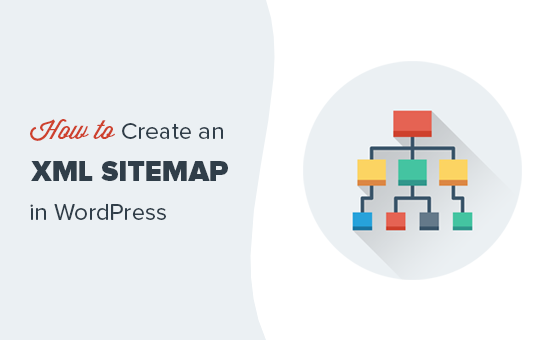
¿Qué es un mapa del sitio XML?
Un mapa del sitio XML es un archivo que enumera todo el contenido de su sitio web en formato XML para que los motores de búsqueda como Google puedan descubrir e indexar fácilmente su contenido.
A principios de la década de 2000, los sitios web gubernamentales solían tener un enlace en sus páginas principales titulado “Mapa del sitio”. Esta página solía contener un anuncio / catálogo / ficha de todas las páginas importantes de ese sitio web.
Aunque algunos sitios web siguen teniendo páginas de mapas del sitio en HTML, el uso general de los mapas del sitio ha evolucionado con los años.
Hoy en día, los mapas del sitio se publican en formato de archivo XML en lugar de HTML, y su público objetivo son los motores de búsqueda y no las personas.
Básicamente, un mapa del sitio XML es una forma que tienen los propietarios de sitios web de informar a los motores de búsqueda acerca de todas las páginas que existen en su sitio web.
También indica a los motores de búsqueda qué enlaces son más importantes que otros y con qué frecuencia actualiza su sitio web.
Aunque los mapas del sitio XML no mejorarán su posicionamiento en los motores de búsqueda, permiten que éstos rastreen mejor su sitio web. Esto significa que pueden encontrar más contenido y empezar a mostrarlo en los resultados de búsqueda, lo que se traduce en más tráfico de búsqueda y una mejora de la clasificación SEO.
Por qué necesita un mapa del sitio XML
Los mapas del sitio son extremadamente importantes desde el punto de vista de la optimización para motores de búsqueda (SEO ).
La simple adición de un archivo de mapa del sitio no afectará a su clasificación en las búsquedas. Sin embargo, si hay una página en su sitio que no está indexada, un mapa del sitio permitirá que los motores de búsqueda sepan acerca de esa página.
Los mapas del sitio son muy útiles cuando se empieza un blog o se crea un sitio web nuevo, porque la mayoría de los sitios web nuevos no tienen vínculos de retroceso. Esto hace que sea más difícil para los motores de búsqueda descubrir todo su contenido.
Por este motivo, los motores de búsqueda como Google y Bing permiten a los propietarios de sitios web nuevos enviar un mapa del sitio en sus herramientas para webmasters. Esto permite a los robots de los motores de búsqueda descubrir e indexar fácilmente su contenido (más información sobre este tema más adelante).
Los mapas del sitio también son importantes para los sitios web populares ya establecidos. Permiten destacar qué partes de su sitio web son más importantes y cuáles se actualizan con más frecuencia para que los motores de búsqueda puedan indexar su contenido en consecuencia.
Dicho esto, veamos cómo crear un mapa del sitio XML en WordPress.
Tutorial en vídeo
Si prefiere instrucciones escritas, siga leyendo.
Existen varias formas de crear un mapa del sitio XML en WordPress. Le mostraremos tres métodos populares para crear un mapa del sitio XML en WordPress. También le mostraremos cómo enviar sus mapas del sitio a los motores de búsqueda y utilizarlos para hacer crecer su sitio.
Método 1: Crear un mapa del sitio XML en WordPress sin plugins
Este método es muy básico y limitado en cuanto a características.
Antes de agosto de 2020, WordPress no tenía mapas del sitio integrados. Sin embargo, en WordPress 5.5, lanzaron una característica básica de mapa del sitio XML.
Esta característica le permite crear automáticamente un mapa del sitio XML en WordPress sin necesidad de utilizar un plugin. Sólo tienes que añadir wp-sitemap.xml al final del nombre de tu dominio, así:
https://www.example.com/wp-sitemap.xml
WordPress le mostrará el mapa del sitio XML por defecto.
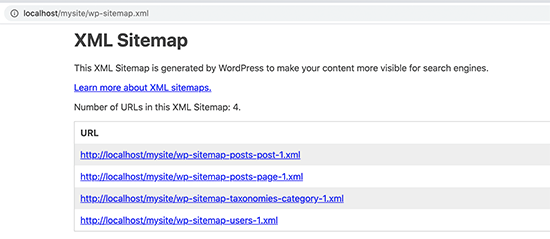
Esta característica de mapa del sitio XML se añadió a WordPress para garantizar que cualquier sitio web nuevo de WordPress no se pierda las ventajas SEO de un mapa del sitio XML.
Sin embargo, no es muy flexible y no se puede controlar fácilmente qué añadir o eliminar de los mapas del sitio XML.
Por suerte, casi todos los mejores plugins SEO para WordPress vienen con su propia funcionalidad de mapa del sitio. Estos mapas del sitio son mejores, y puedes controlar qué contenido quitar / excluir de tus mapas del sitio XML de WordPress.
Método 2: Crear un mapa del sitio XML en WordPress con AIOSEO
La forma más sencilla de crear un mapa del sitio XML en WordPress es utilizando el plugin All in One SEO (AIOSEO) para WordPress.
Es el mejor plugin SEO para WordPress del mercado, que le ofrece un generador de mapas del sitio y un completo conjunto de herramientas para optimizar las entradas de su blog para SEO.
En primer lugar, debe instalar y activar el plugin All in One SEO. Para más detalles, consulte nuestra guía paso a paso sobre cómo instalar un plugin de WordPress.
La característica del mapa del sitio también está disponible en la versión gratuita de AIOSEO. Sin embargo, para obtener mapas del sitio de noticias avanzadas y mapas del sitio de vídeo, necesitará la versión Pro.
Una vez activado, vaya a la página Todo en Uno SEO ” Sitemaps para establecer los ajustes del mapa del sitio.
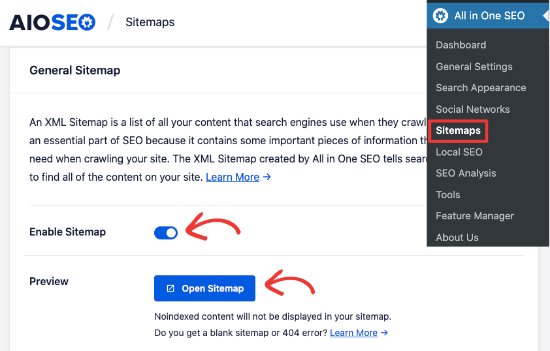
Por defecto, All in One SEO activará la característica del mapa del sitio para usted y reemplazará los mapas del sitio básicos de WordPress.
Puede hacer clic en el botón “Abrir mapa del sitio” para ver una vista previa de su aspecto. También puede ver su mapa del sitio añadiendo sitemap.xml a la URL de su sitio web, por ejemplo:
https://www.example.com/sitemap.xml

Como principiante, no necesitas hacer nada, ya que los ajustes por defecto funcionarán para todo tipo de sitios web, blogs y tiendas online.
Sin embargo, puede personalizar los ajustes del mapa del sitio para controlar lo que desea incluir en su mapa del sitio XML.
Sólo tiene que desplazarse hasta la sección “Ajustes del mapa del sitio”.

Esta sección le ofrece opciones para gestionar los índices del mapa del sitio e incluir o excluir tipos de entradas y taxonomías(categorías y etiquetas). También puede activar mapas del sitio XML para archivos basados en fechas y archivos de autor.
All in One SEO incluye automáticamente todo el contenido de WordPress en los mapas del sitio XML. Pero, ¿y si tienes páginas independientes como un formulario de contacto, una página de destino o páginas de tiendas Shopify que no forman parte de WordPress?
Pues bien, AIOSEO es el solo plugin que te permite añadir páginas externas a tu mapa del sitio de WordPress. Simplemente desplázate hasta la sección ‘Páginas adicionales’ y actívalo. Esto te mostrará un formulario donde puedes añadir cualquier página personalizada que quieras incluir.
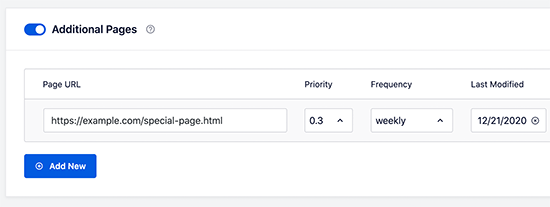
Sólo tiene que añadir la URL de la página que desea incluir y, a continuación, establecer una prioridad en la que 0,0 es la más baja y 1,0 la más alta. Si no está seguro, le recomendamos que utilice 0,3.
A continuación, elija la frecuencia de las actualizaciones y la fecha de la última modificación de la página.
Puede hacer clic en el botón “Añadir nuevo” si necesita añadir más páginas.
No olvides hacer clic en el botón “Guardar cambios” para establecer los ajustes.
Excluir entradas y páginas específicas de su mapa del sitio XML
All in One SEO le permite excluir cualquier entrada o página de sus mapas del sitio XML. Puede hacerlo al hacer clic en la sección ‘Ajustes avanzados’ en la página All in One SEO ” Sitemaps.

También puede quitar / eliminar una entrada o página de sus mapas del sitio XML haciendo que sea no-index y no-follow. Esto impedirá que los motores de búsqueda muestren ese contenido en los resultados de búsqueda.
Simplemente edite la entrada o página que desea excluir y desplácese hasta el cuadro de ajustes de AIOSEO situado debajo del editor.
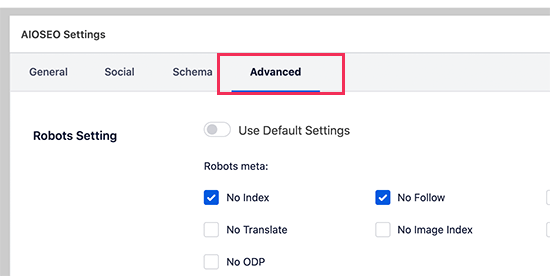
Desde aquí, debe cambiar a la pestaña Avanzado y marcar las casillas siguientes a las opciones “Sin índice” y “Sin seguimiento”.
Creación de mapas del sitio adicionales
All in One SEO le permite crear mapas del sitio adicionales, como un mapa del sitio de vídeo o de noticias.
Puede crear un mapa del sitio de vídeo si incrusta vídeos regularmente en las entradas o páginas de su blog. Esto permitirá que los motores de búsqueda muestren las entradas en los resultados de búsqueda y de búsqueda de vídeos junto con una miniatura del vídeo.
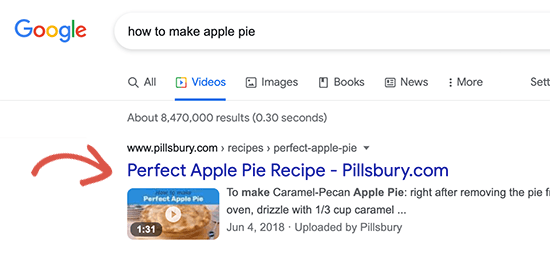
También puedes crear un mapa del sitio de noticias si diriges un sitio web de noticias y quieres aparecer en los resultados de búsqueda de Google Noticias.
Simplemente vaya a All in One SEO ” Sitemaps y cambie a las pestañas Mapa del sitio de vídeo o Mapa del sitio de noticias para generar estos mapas del sitio.
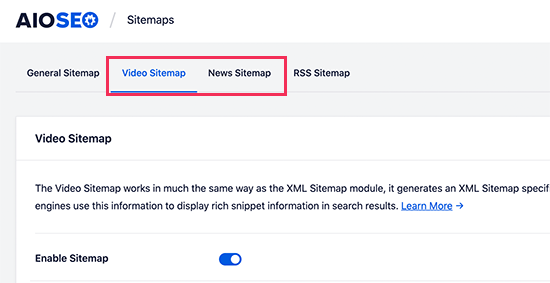
En general, AIOSEO es el mejor plugin para WordPress porque te ofrece toda la flexibilidad y potentes características a un precio muy asequible.
Método 3: Creación de un mapa del sitio XML en WordPress con Yoast SEO
Si utiliza Yoast SEO como plugin de SEO para WordPress, también activará automáticamente los mapas del sitio XML.
En primer lugar, debes instalar y activar el plugin Yoast SEO. Para más detalles, consulta nuestra guía paso a paso sobre cómo instalar un plugin de WordPress.
Una vez activado, vaya a la página SEO ” General y cambie a la pestaña ‘Características’. A continuación, desplácese hasta la opción “Mapa del sitio XML” y asegúrese de que está activada.

A continuación, haz clic en el botón “Guardar cambios” para guardarlos.
Para comprobar que Yoast SEO ha creado un mapa del sitio XML, puede hacer clic en el icono con forma de interrogación situado al lado de la opción “Mapas del sitio XML” de la página.
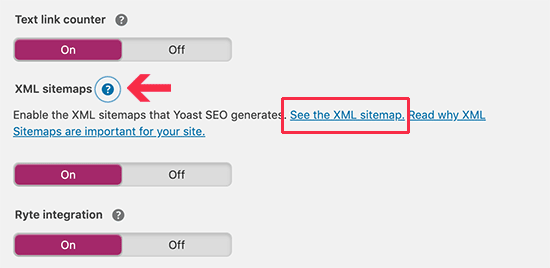
Después de eso, haga clic en el enlace “Ver el mapa del sitio XML” para ver su mapa del sitio XML en vivo generado por Yoast SEO.
También puede encontrar su mapa del sitio XML simplemente añadiendo sitemap_index.xml al final de la dirección de su sitio web. Por ejemplo:
https://www.example.com/sitemap_index.xml
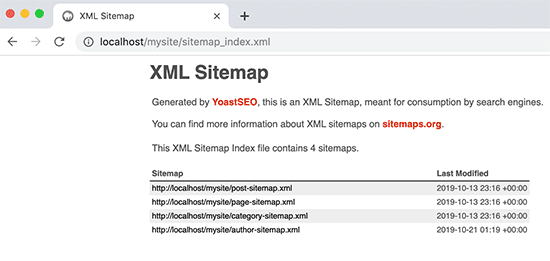
Yoast SEO crea múltiples mapas del sitio para diferentes tipos de contenido. Por defecto, generará mapas del sitio para entradas, páginas, autores y categorías.
Envío del mapa del sitio XML a los motores de búsqueda
Los motores de búsqueda son bastante inteligentes a la hora de encontrar un mapa del sitio. Cada vez que publica nuevo contenido, se envía un ping a Google y Bing para informarles acerca de los cambios en el mapa del sitio.
Sin embargo, le recomendamos que envíe el mapa del sitio manualmente para asegurarse de que los motores de búsqueda puedan encontrarlo.
Envío del mapa del sitio XML a Google
Google Search Console es una herramienta gratuita que ofrece Google para ayudar a los propietarios de sitios web a supervisar / seguir / vigilar la presencia de su sitio en los resultados de búsqueda de Google.
Si añades el mapa del sitio a Google Search Console, el sistema descubrirá rápidamente tu contenido, incluso si tu sitio web es nuevo.
En primer lugar, debes visitar el sitio web de Google Search Console y acceder a una cuenta.
A continuación, se le pedirá que seleccione un tipo de propiedad. Puede elegir un dominio o un prefijo URL. Le recomendamos que elija un prefijo URL, ya que es más fácil de establecer.

Introduzca la URL de su sitio web y haga clic en el botón “Continuar”.
A continuación, se le pedirá que verifique la propiedad del sitio web. Verá varios métodos para hacerlo. Le recomendamos que utilice el método de la etiqueta HTML.

Sólo tiene que copiar el código que aparece en la pantalla y luego ir a la zona de administrador de su sitio web WordPress.
Si está utilizando AIOSEO, entonces viene con una fácil verificación de herramientas para webmasters. Simplemente ve a Todo en Uno SEO ” Ajustes Generales y luego haz clic en la pestaña ‘Herramientas para webmasters’. A continuación, introduzca el código de Google.

Si no utiliza AIOSEO, puede introducir el código utilizando el plugin WPCode. Esta es la forma más segura y fácil de añadir código a su sitio de WordPress.
Necesitas instalar y activar el plugin gratuito WPCode. Para más detalles, consulta nuestra guía paso a paso sobre cómo instalar un plugin de WordPress.
Una vez activado, debe visitar la página Fragmentos de código ” Cabecera y pie de página y añadir el código que ha copiado anteriormente en la casilla “Cabecera”.
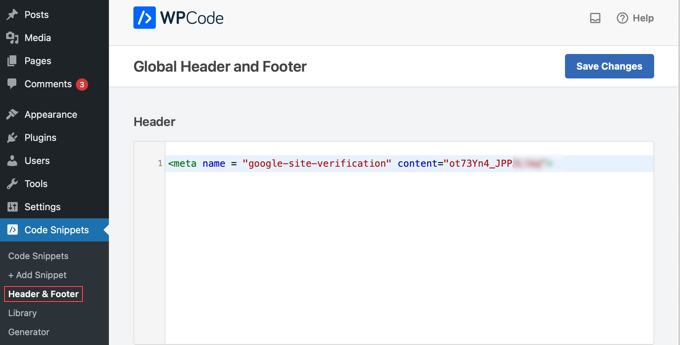
No olvides hacer clic en el botón “Guardar cambios” para guardar las modificaciones.
Ahora, vuelve a la pestaña de Google Search Console y haz clic en el botón “Verificar”.
Google comprobará si hay un código de verificación en tu sitio y, a continuación, lo añadirá a tu cuenta de Google Search Console.
Nota: Si la verificación no se realiza correctamente, asegúrese de vaciar la caché de WordPress y vuelva a intentarlo.
Ahora que ha añadido su sitio web, vamos a añadir también su mapa del sitio XML.
Desde el Escritorio de su cuenta, tiene que hacer clic en “Sitemaps” en la columna de la izquierda.

A continuación, añada la última parte de la URL del mapa del sitio en la sección “Añadir un nuevo mapa del sitio” y haga clic en el botón “Enviar”.
Google añadirá la URL del mapa del sitio a Google Search Console.
Google tardará algún tiempo en rastrear su sitio web. Después de un tiempo, podrás ver las estadísticas básicas del mapa del sitio.
Esta información incluye el número de enlaces que Google ha encontrado en el mapa del sitio, cuántos de ellos se han indexado, la proporción entre imágenes y páginas web, etc.
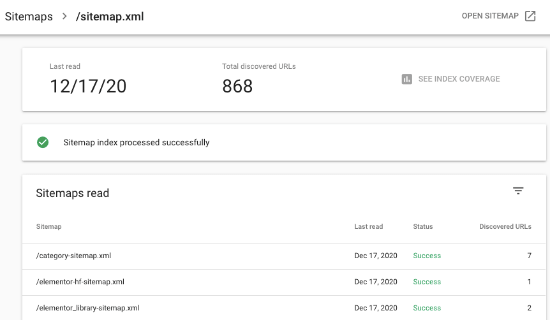
Envío del mapa del sitio XML a Bing
De forma similar a Google Search Console, Bing también ofrece Bing Webmaster Tools para ayudar a los propietarios de sitios web a supervisar / seguir / vigilar su sitio web en el motor de búsqueda de Bing.
Para añadir el mapa del sitio a Bing, debe visitar el sitio web Herramientas para webmasters de Bing.
Aquí verás dos opciones para añadir tu sitio. Puede importar su sitio desde Google Search Console o añadirlo manualmente.

Si ya has añadido tu sitio a Google Search Console, te recomendamos que lo importes. Le ahorrará tiempo, ya que el mapa del sitio se importará automáticamente.
Si decide añadir su sitio manualmente, deberá introducir la URL de su sitio y verificar el sitio.
Bing le pedirá ahora que verifique la propiedad de su sitio web y le mostrará varios métodos para hacerlo.
Recomendamos utilizar el método de la meta etiqueta. Simplemente copie la línea de la meta etiqueta de la página y diríjase a su escritorio de WordPress.
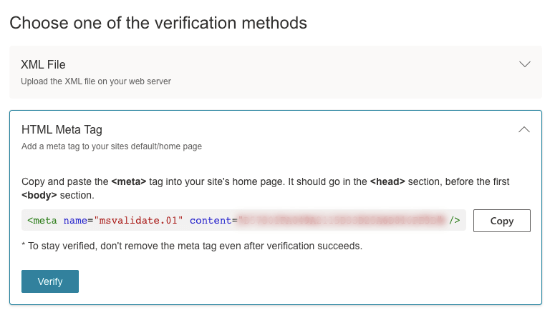
Ahora, instala y activa el plugin WPCode Free en tu sitio web
Una vez activado, debe visitar la página Fragmentos de código ” Cabecera y pie de página y añadir el código que ha copiado anteriormente en la casilla “Cabecera”.

No olvides hacer clic en el botón “Guardar cambios” para guardar las modificaciones.
Uso de mapas del sitio XML para hacer crecer su sitio web
Ahora que ya ha enviado el mapa del sitio XML a Google y Bing, veamos cómo utilizarlo para su sitio web.
En primer lugar, debe tener en cuenta que el mapa del sitio XML no mejora su clasificación en los motores de búsqueda. Sin embargo, sí ayuda a los motores de búsqueda a encontrar contenido, ajustar la tasa / tarifa de rastreo y mejorar la visibilidad de su sitio web en los motores de búsqueda.
Debe consultar las estadísticas de su mapa del sitio en Google Search Console. Puede mostrarte los errores de rastreo y las páginas excluidas de la cobertura de búsqueda.
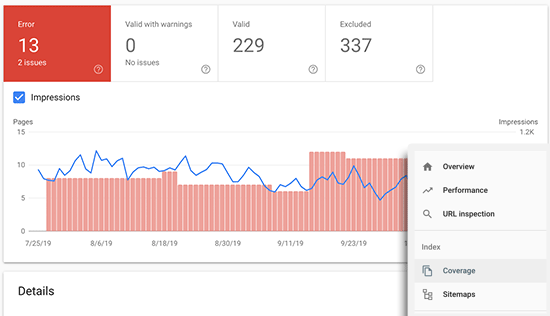
Debajo de los gráficos, puede hacer clic en las distintas tablas.
Aquí puede ver las URL reales que Google ha excluido o no ha indexado.

Normalmente, Google puede decidir omitir el contenido duplicado, las páginas sin contenido o con muy poco contenido y las páginas excluidas por el archivo robots.txt o las metaetiquetas de su sitio web.
Sin embargo, si tiene un número inusualmente alto de páginas excluidas, puede que quiera marcar / comprobar los ajustes de su plugin SEO para asegurarse de que no está bloqueando ningún contenido.
Para obtener más información, consulta nuestra guía completa de Google Search Console para principiantes.
Esperamos que este artículo te haya ayudado a aprender sobre los mapas de sitio XML y cómo crear un mapa de sitio XML para tu sitio de WordPress. También puedes consultar nuestra guía sobre cómo crear un mapa del sitio multilingüe en WordPress y nuestra selección de las mejores herramientas de búsqueda de palabras clave para escribir mejores contenidos.
If you liked this article, then please subscribe to our YouTube Channel for WordPress video tutorials. You can also find us on Twitter and Facebook.





Mrteesurez
This article is helpful to me.
But I don’t normally create a site map manually, I heard search engines crawl WordPress sites automatically without a need to manually submit your sitemap.
Am I right or wrong ??
WPBeginner Support
Search engines can crawl your site without a sitemap but we recommend adding a sitemap as it helps tell search engines the content available to crawl on your site instead of waiting for search engines to find the content.
Admin
Ahmed Omar
thank you for the valuable helpful post
I liked the video as it made it more easy and step by step, Actually when I find a video in the post, I feet comfortable that I will finish the issue
I am using Yoast for site mapping and it is working fine with me
Thank you
WPBeginner Support
You’re welcome, glad you found our post helpful
Admin
szymon majewski
Hi. I have a problem with my sitemap. I’m trying to add my sitemap to google search console and unfortunately I’m getting the error site cannot be added. After checking the url of the map, search console tells me the error: Is indexing allowed
error
No: The tag “noindex” was detected in the “X-Robots-Tag” http header.
I tried to find this tag in many ways but I don’t see it anywhere.
Please help me, best regards.
WPBeginner Support
The error looks like your robots.txt is blocking Google, you would need to check your robots.txt file. Our guide below should be able to help with finding and editing your robots.txt file.
https://www.wpbeginner.com/wp-tutorials/how-to-optimize-your-wordpress-robots-txt-for-seo/
Admin
Donny
Thank for this article it was very helpful
WPBeginner Support
Glad to hear our guide was helpful!
Admin
Viany Sole Cruz
Thank You. This was so helpful!
WPBeginner Support
Glad our article was helpful
Admin
Wajid Khan
I am a beginner, I have new sitemap and want to update new sitemap in AIOSEO Lite plugin but I couldn’t find option to update or add new or remove sitemap in the plugin, please guide me how to update sitemap in AIOSEO Lite plugin.
WPBeginner Support
The sitemap should automatically update over time at the moment
Admin
Shyam
Can I submit more than one sitemap? I have submitted a sitemap created by yoast seo and the one created by jetpack. Does this affect any?
WPBeginner Support
We would recommend only submitting one sitemap and not using multiple plugins for creating sitemaps as that can cause issues.
Admin
Felicity
Thank you, this was really concise and helpful
WPBeginner Support
Glad our article was helpful
Admin
Govind
this was all I needed, thank you
WPBeginner Support
Glad our guide was helpful
Admin
Joanne Tjahyana
When I submitted it to Google Search Console, it says “couldn’t fetched”.
So what should I do now?
WPBeginner Support
The most common solution would be to clear your caching and resave your permalinks.
Admin
Anil
I have shifted my website from blogger.com to wordpress. Do I need to resubmit xml sitemap in Google search console?
WPBeginner Support
To be safe you would want to resubmit the sitemap
Admin
Zohaib
Very informative. Thank you!
WPBeginner Support
You’re welcome
Admin
Aditaya
can we delete the pugin after use or its will important for that.
WPBeginner Support
The plugin is generating your sitemap so you would want to keep the plugin active on your site.
Admin
Ari
Hello, thank you very much for the great information, your website is very helpful! I got a question about sitemap, I follow all the steps but in the end when I add the last part of your sitemap URL to ‘Add new sitemap’ section and click Submit, it doesn´t show me an amount of links, it shows that I have 0 links. What could be the problem?
Thank you in advance)
WPBeginner Support
You would want to visit the address on your site to check if there are any errors. You may also want to resave your permalinks for a common solution.
Admin
onyenucheya Chinecherem
Hello admin thanks for this article, but I’m confused to an extent and here is my question; is there any negative effect of submitting both www and non www sitemap to webmasters?
WPBeginner Support
It could cause some reporting issues, it is normally best to submit the sitemap with the URL you would like to have appear on Google’s search
Admin
Anisha Shrestha
I was Struggling to verify my sitemap in google before. Now i added It. Very Useful article. Thank you for Sharing.
WPBeginner Support
Glad you found our article helpful
Admin
sibasis
Very infirmative as I was struggling to verify mt site with goggle and bing.
THANK YOU
WPBeginner Support
Glad our guide was helpful
Admin
Rituparna
Very very useful post. I was struggling with the sitemap and its submission to Google Search Console. Now sorted. Thank you.
WPBeginner Support
Glad our guide was helpful
Admin
saba
very helful guide. thanks for sharing
WPBeginner Support
You’re welcome
Admin
Metodi
I find this article very helpfull, but I want to ask you something. I use Yoast SEO, but now need to generate separate XML sitemap for images. Could you reccomend me a plugin for that. Thanks
WPBeginner Support
Yoast currently has the option of including images in the sitemap so you shouldn’t need an additional plugin
Admin
Liv
This article was very helpful. I used the Yoast SEO method. Thank you
WPBeginner Support
You’re welcome, glad our guide could help
Admin
Suzanne
Thanks so much for this it was a massive help! Because I verified and uploaded to Google Console first, I managed to verify and import my website/sitemap to Bing by just connecting my google account (Bing gives you an option for this when you click on sign up) – it was done in less than 30 seconds! I wouldn’t have thought to do Bing, so thank you so much for covering that too!
WPBeginner Support
You’re welcome, glad our guide was helpful
Admin
Tasha
This is honestly the most helpful article I’ve ever seen. I’m not a developer (just new home business owner trying to figure out the rabbit hole that is web dev) and this guided me through all the unknowns I’d had about importance of a sitemap, let alone how it would benefit my site. THANK YOU SO MUCH!
WPBeginner Support
You’re welcome, glad our guide was helpful
Admin
Brittney Gage
I rarely write comments on articles but this was easily one of the most helpful I’ve ever read. Thank you!
WPBeginner Support
Glad our article was helpful
Admin
Harish Nemade
I have my site with only one post published, so is it necessary to submit a sitemap each time when I added a new Article/Post?
And how often should I submit sitemap?
WPBeginner Support
You only need to submit your sitemap once unless there is an error, it will update as you add posts.
Admin
Image Earth Travel
Great article!
Yt’s a pain that the Yoast plugin (as with all plugins) are only offered on the WP’s Business Plan. I’ve been on the Premium Plan and not allowed to install plugins.
WPBeginner Support
Thank you, part of the confusion may be due to our articles being for WordPress.org sites which require hosting instead of the business plan on WordPress.com https://www.wpbeginner.com/beginners-guide/self-hosted-wordpress-org-vs-free-wordpress-com-infograph/
https://www.wpbeginner.com/beginners-guide/self-hosted-wordpress-org-vs-free-wordpress-com-infograph/
Admin
Sarah
I am using the free Yoast SEO plugin but I am not seeing SEO » XML Sitemaps. Any ideas? Thanks
WPBeginner Support
Yoast has updated their interface so you should find it under SEO>General>Features at the moment.
Admin
flyingvan
Thanks for this tutorial, I could activate the sitemap on my website thanks to you.
Mat
WPBeginner Support
You’re welcome, glad our article could be helpful
Admin
Sara
Hello,
Recently I added the sitemap for my website. But, while checked with the tool, it’s showing, no sitemap is added. Why it’s showing like this. I added Yoast SEO plugins.
WPBeginner Support
It could be their caching or if your site has caching that you haven’t cleared it could be part of the issue.
Admin
Jishnu.M
Hi,
I have a problem with sitemap submitting….I am using Yoast SEO when I submit a sitemap to google webmaster it says “couldn’t fetch”…….. but i have successfully submitted sitemap to bing and Yandex without any errors …what to do please help me
WPBeginner Support
For an error like this, you may need to reach out to Yoast’s support to see their recommended troubleshooting for specifically Google not being able to crawl your sitemap.
Admin
Sajol Fuad
I am really happy to get this article about sitemap.
I am using Yoast SEO for sitemaps. Some SEO auditor is saying that I should improve it immediately. But Google search console is showing a green success and assuring that all is ok.
Can you please suggest me what should I do right now?
Thanks for the article..
WPBeginner Support
We’re using the Yoast sitemap without any issues at the moment. If you would prefer what the auditor wants then you could certainly try that if you wanted.
Admin
Charles Harris
I have Yoast SEO but XML sitemaps does not appear on the menu, which indeed looks very different from yours. Any suggestions as to how to find it?
WPBeginner Support
For the current Yoast interface, the Sitemap options are under SEO>General>Features
Admin
Charles Harris
Thanks – got it now.
Joseph
I need some help please,
some pages on my website are not showing on sitemap.xml
I entered it manually to google console, It showed an error that the sitemap format is HTML and that I should change the format
how do I change sitemap format, please?
WPBeginner Support
If you’re using a caching plugin you may want to try to disable it to see if it could be a conflict between Yoast and the caching plugin you’re using.
Admin
Ravi
Hi, awesome tutorial, I did same as your instruction and working fine. But there’s a problem with this, check out the details.
my website is yahoonewsz.com and when I type “www.example.com/sitemap_index.xml”, it works fine but it says page not found when typed “example.com/sitemap_index.xml”.
Why?
WPBeginner Support
You may want to check with your hosting provider that there is not a setting preventing the non www version from redirecting properly
Admin
Arun Dixit
Thanks for your best tutorial!
I recently have a wordpress blog and have created xml sitemap using yoast seo, according to this tutorial in previous month. Yesterday I happend to see my xmlsitemap file at my wp-admin. There are only 5-6 lines which covers my new posts only. What about my old posts? Is there any problem? And how come I know that there is any problem? Because I have more than dozen posts till now.
Kindly let me know.
Arun Dixit
WPBeginner Support
You may want to clear your caching and reach out to Yoast if your sitemap is refusing to update your older posts if you’re not excluding them.
Admin
Darko Loncar
I am using All in One SEO pack Plugin. If I download Yoast’s WordPress SEO plugin should I use both?
WPBeginner Support
No, we would not recommend having multiple SEO plugins active as they can conflict with each other.
Admin
Kirti Goyal
THANKS FOR SHARING THIS INFORMATION!
one thing I want to know is that whether after every single update in pages, posts or change within a post, we need to submit the sitemap???
Looking forward to hearing from you.
WPBeginner Support
You should not need to resubmit your sitemap as long as Google does not run into any errors with your sitemap and with the method from our article it should over time update your sitemap.
Admin
Viraj
Please guide me to make a news sitemap for google news submission.
Luke
I followed these steps but search console is giving me a 404 on the sitemap. I never had such problems submitting sitemaps
Mohammed
In my website, I generated sitemap using this tutorial, however I want to remove one particular non-existent URL from the sitemap as it’s giving 404 error and google adsense is showing crawl error. How do I remove one particualr URL from sitemap and ask google to stop crawling that URL?
Ernest
I see some websites have multiple sitemaps. Is it really necessary?
Dibyajyoti
not really. But some large website for multiple purpose .
greeshma
is sitemaps still relevant in 2018?
WPBeginner Support
Hi Greeshma,
Yes, they are.
Admin
PRANITA DESHPANDE
My site has been verified but can’t find site map near to it .What to do for it ?
cher
I did your step for the sitemap. Awesome! Also, for my robots.txt file I have the following, should I change that first line of sitemap to what yoast says? I am not even sure where I got that old sitemap from but don’t want to mess anything up.
WPBeginner Support
Hi Cher,
Yes, if you are using Yoast SEO, then you should add Yoast SEO sitemap.
Admin
Jude
Hi.
Very helpful information.
I want to ask if it is okay to submit my site to other webmasters like bing, yandex and others.
Thanks so much.
WPBeginner Support
Hi Jude,
Yes, it is OK.
Admin
jude
Thanks so much.
I can’t find my sitemap code in yoast.
I also can’t verify my site on other search console like yandex and bing. (i got cannot verify)
daguah
which social plugin do you use to show the number of shares?
jude
hi. you can use share count or sassy social share
Anshuman Konwar
Thank you Sir, this article is very helpful
William
Is there any one who can help me to change sitemap.xml to some new url like sitmap_page_xml
Leo August
Yoast SEO must have been updated because the check boxes are now sliders – at least on my site. When I enable the stiemap function, then click the link to view the site map, I get a 404 Not Found error. Did I do something wrong?
Rachael
Really helpful article! I have just having trouble when it comes to viewing my site map, it’s coming up with 404 error and I’m not sure why?